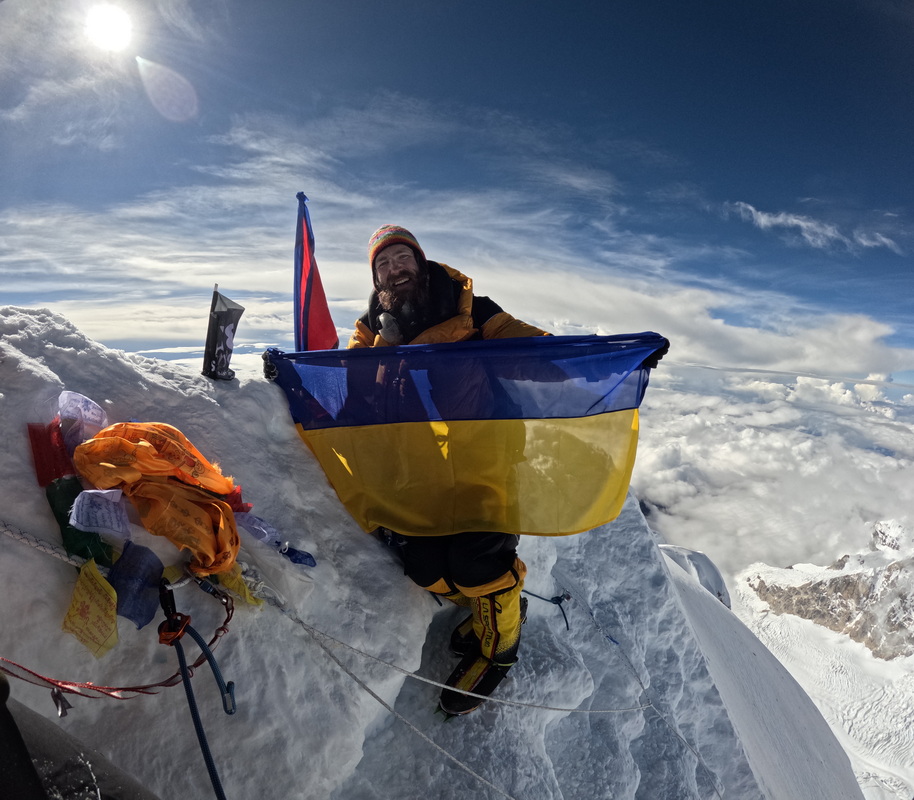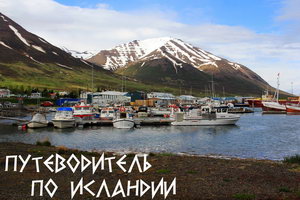Oops, I did it again.
3 years ago, after returning from the Lhotse expedition I said - NEVER AGAIN!
This time mount Manaslu - the eighth-highest mountain in the world at 8163 metres. As always, I have the ultimate plan - climb without oxygen and without a sherpa guide. So, in "solo" style (if we do not count other ~300 climbers on the mountain).
And as always something went wrong...
Why did I choose Mount Manaslu?
There are 14 mountains in the world that stand over 8,000 meters, each with its own challenges, its own personality.
Often called the ‘Mountain of the Spirit,’ Manaslu offers a unique combination of beauty and difficulty. Unlike Everest or some of the other famous peaks, Manaslu is more remote, more wild.
Some years ago I already tried to climb 8000 peak, that time it was mount Lhotse - 4th highest mountain in the world. I failed, I mean, I did not reach the summit, but hopefully all the experience I get, help me to do everything right this time.
Climbing Manaslu isn’t just a physical challenge—it’s mental. The weather is unpredictable, the route is technical, and avalanches are a constant threat. But for me, that’s what makes it so rewarding.
And to make it even more challenging - I’ll try to reach the summit without supplementary Oxygen and without the support of a Sherpa guide - on my own. One to one - just me and the mountain (and 300 other climbers who wanna do the same).
Journey to Base Camp
So here I am, just landed in Kathmandu. Now is the beginning of September 2024. But here it feels like the middle of the summer.
Before the climb begins, there's the journey to base camp—a trek that’s just as much a part of the adventure as the climb itself. Reaching Mount Manaslu means travelling deep into the heart of Nepal, through rugged landscapes and remote villages, all the way to the foot of the mountain.
Well, actually, instead of 7 days hiking to the basecamp, you can get a Helicopter, and do it in 1 day. Which is definitely easier, but not better from the acclimatization point of view. Because during hiking you giant the altitude step by step. And also on the way to basecamp you can cross the mountain pass as high as 5100 meters, which is higher than basecamp.
It all starts in Kathmandu, first a bus ride to the end of an asphalt road. Then jeep by the shaky and scary mountain roads.
The trail to Manaslu is wild, remote, and incredibly scenic. You pass through tiny villages where time seems to have stood still, with locals living much the same way they have for centuries. There’s something humbling about walking through these places, where the pace of life is so different from the rest of the world.
Suspension bridges stretch across roaring rivers, dense forests give way to wide open valleys, and the higher you go, the more the landscape changes. The air grows thinner, the temperatures drop, and the peaks start to rise around you, reminding you just how far you’ve come.
The trek is a gradual ascent, giving your body the time it needs to adjust to the altitude. Along the way, you’re constantly surrounded by towering mountains, cascading waterfalls, and landscapes that seem almost too beautiful to be real.
For the trekking part I’m in an international team with other climbers. We are walking with smaller backpacks while the main part of our equipment is heading directly to the basecamp by the caravan of mules.
The main challenge on the way to the basecamp is Larke Pass (Larkya La). It is located at an altitude of 5106 meters above sea level. It is the highest point of the Manaslu Trek.
The last village before the basecamp was Samagaon. Here I can sleep inside a house on a normal bed for the last time.
After days of trekking ( and 10 days as I left home), I finally reached base camp, sitting at around 4,800 meters. It feels like a different world—a frozen landscape beneath the shadow of the massive mountain towering above. This is where the real climb begins, but even just reaching base camp feels like an achievement in itself.
From here, you can see the challenge ahead. The summit seems impossibly far away, but the excitement is undeniable.
And now, the climb is about to begin.
Life at Base Camp
Life at base camp is about adjusting—both physically and mentally. The first few days are all about preparing your body for the climb. You rest, hydrate, and take short hikes up the surrounding ridges to slowly adapt to the thinning air. Every step is part of the process. (me and other climbers who did a trek have the advantage of already being on a higher altitude. Do you remember that Pass on the way?)
So the rest of the first day I just rested in the basecamp and organised my stuff in the tent.
By the way this year I have a new kind of tent - it is much bigger than before - man can stand inside. And it is insulated, so it is not so hot during the day and not cold during the night.
According to best practices, the next day I also should just rest. But it was way too difficult, I feel that I have to go up.
So I found a trade-off - I go to Camp 1 with some of my equipment to make a deposit and go back to the basecamp the same day.
The Rotation
Today, I’m heading up to Camp 1 for the first time. The plan is to carry some supplies, food, and equipment to leave there as part of our acclimatisation process.
In high-altitude mountaineering, you don’t just go straight up the mountain. You climb high and sleep low, moving between camps multiple times to let your body adjust to the thin air.
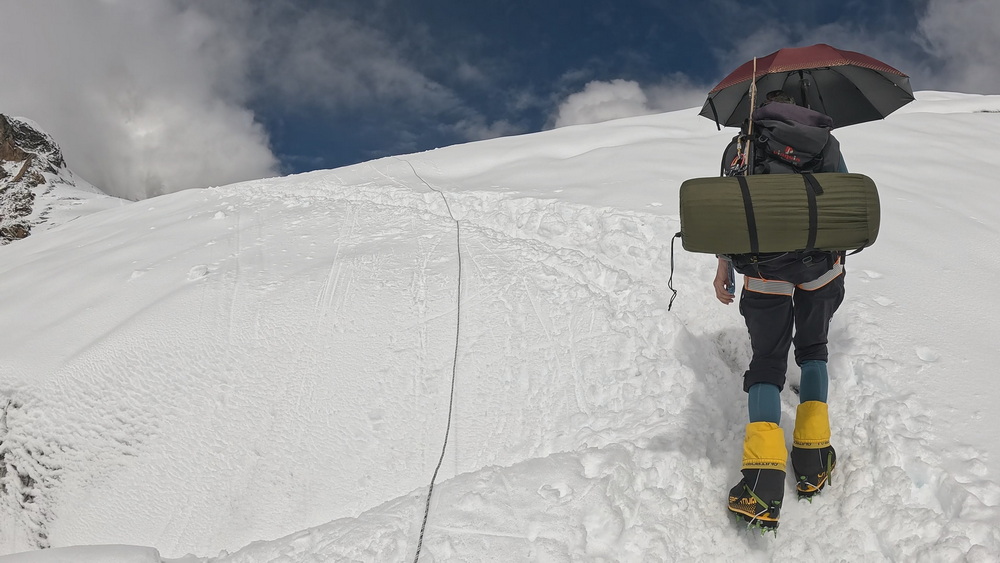
The route from Base Camp to Camp 1 is sometimes steep and demanding, with snow-covered slopes and technical sections that require to be careful. It’s about a 1,200-meter climb, and every step feels heavier as the altitude takes its toll. But the scenery is incredible—the towering peaks around us, the deep valleys below, and the constant reminder of how remote we are out here.
The trail starts from the glacial morena (where basecamp is located). You have to climb one steep rocky section and after some time there is a crampon point. Where the route enters the glacier covered section.
Few huge crevices to cross, and after, there is a first challenge - vertical ice wall.
After it there is a long-long snow section - the most exhausting part (at least for me ). First tents of camp 1 are on the hill slope.
Once I reach Camp 1, I deposit the gear—food, and some essential equipment that we’ll need for the higher camps. I just left it in the kitchen tent of Seven Summits Treks.
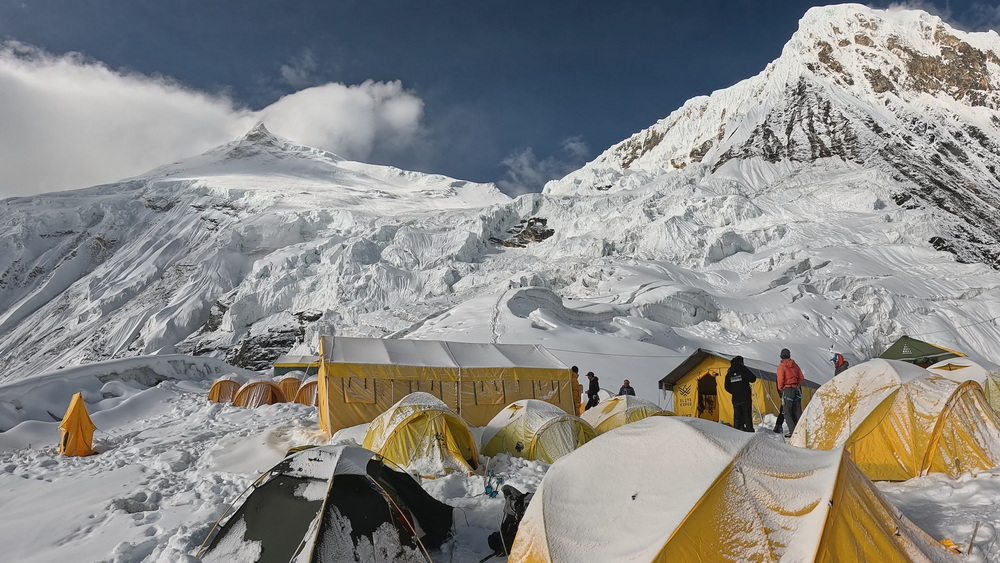
It feels good to lighten the load and after dropping everything off, it’s straight back down to base camp.
The next morning, I’m back on the same route, but this time, I’m carrying more gear—and planning to spend the night at Camp 1. Moving between camps like this helps to acclimatise gradually, giving my body time to adjust to the lower oxygen levels.
As I make my way up, the familiar terrain feels different. But reaching Camp 1 again feels like progress. I set up the tent, unpack the equipment, and settle in for the night.
Sleeping at Camp 1 is a whole new challenge. The altitude makes it difficult to get a good night's rest—your heart is racing, and you can feel every breath you take. But this is all part of the process. Every night spent higher up the mountain brings me closer to the goal.
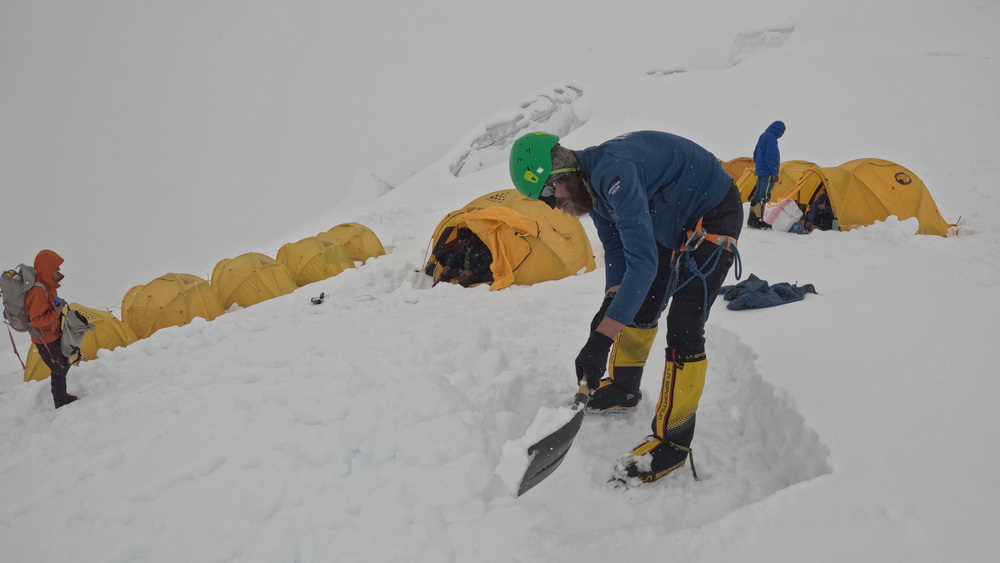
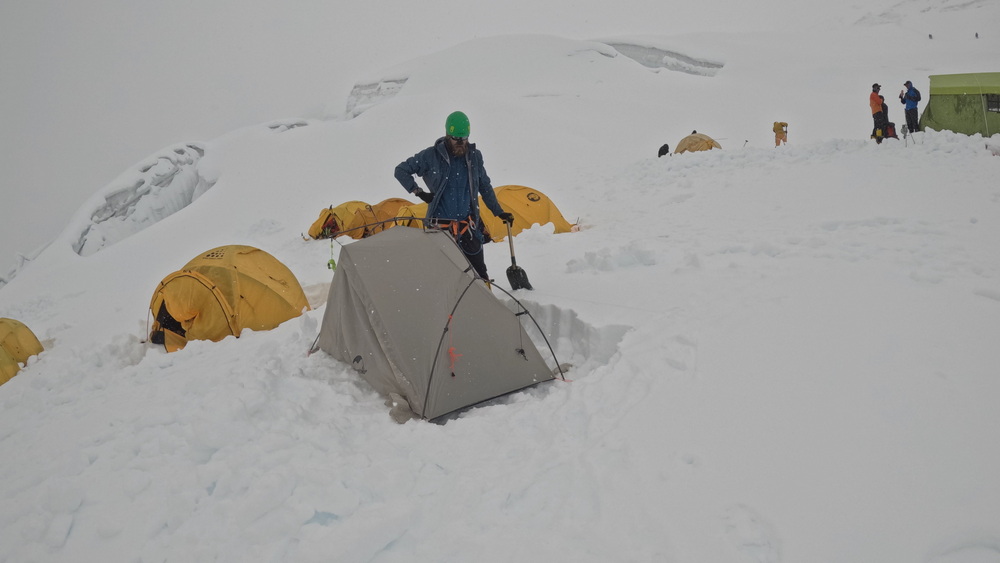
The next morning, I pack up and start the push from Camp 1 to Camp 2. This is where things get more serious — the route is steeper, and the terrain more technical. And now I have a heavy loaded backpack. To Camp1 I did it in two rotations. And to Camp 2 I have to carry all the stuff at once.
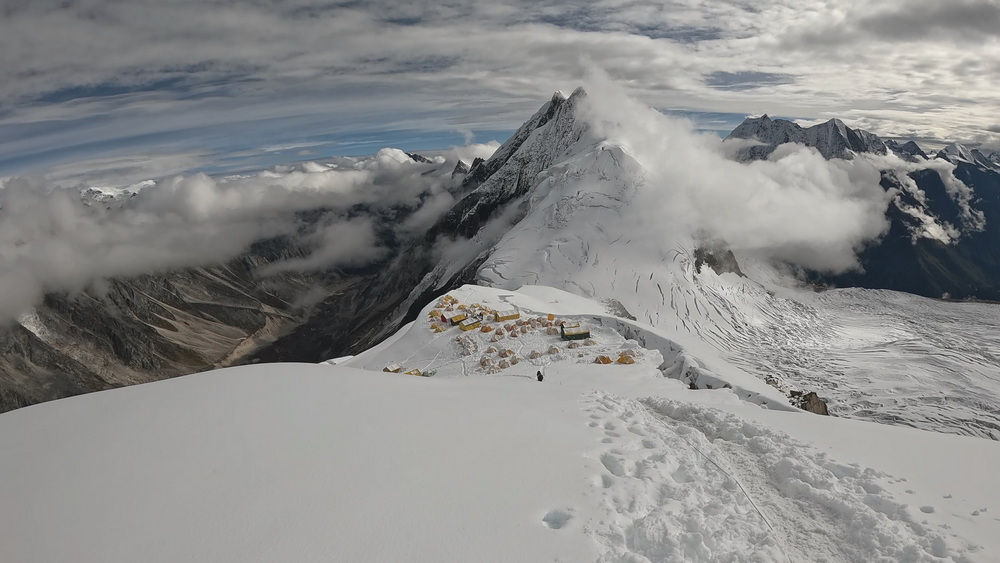
All the way from C1 to C2 is going by very steep icefall. There are sections where you’re climbing through ice fields and crevasses. There are leaders, ice walls and so many people…
I spent half of the time (maybe not so much) waiting in queues.
Climbing from Camp 1 to Camp 2 is all about managing your energy. Every step feels like a battle against the altitude, but it’s also exhilarating to see how far you’ve come.
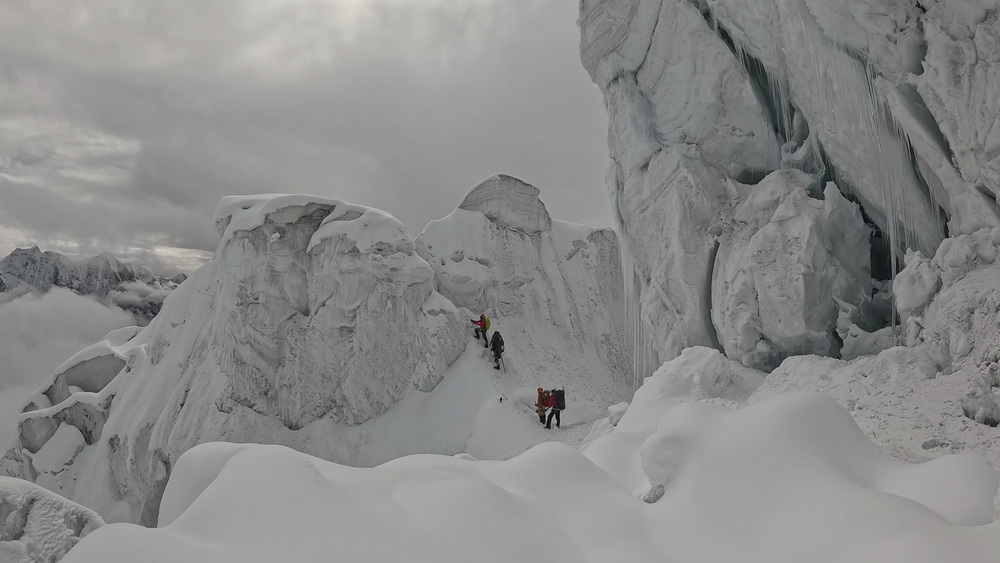
As I gain elevation, the views are nothing short of breathtaking—the Himalayas spread out beneath you in all directions, and you realise just how small you are in this vast landscape.
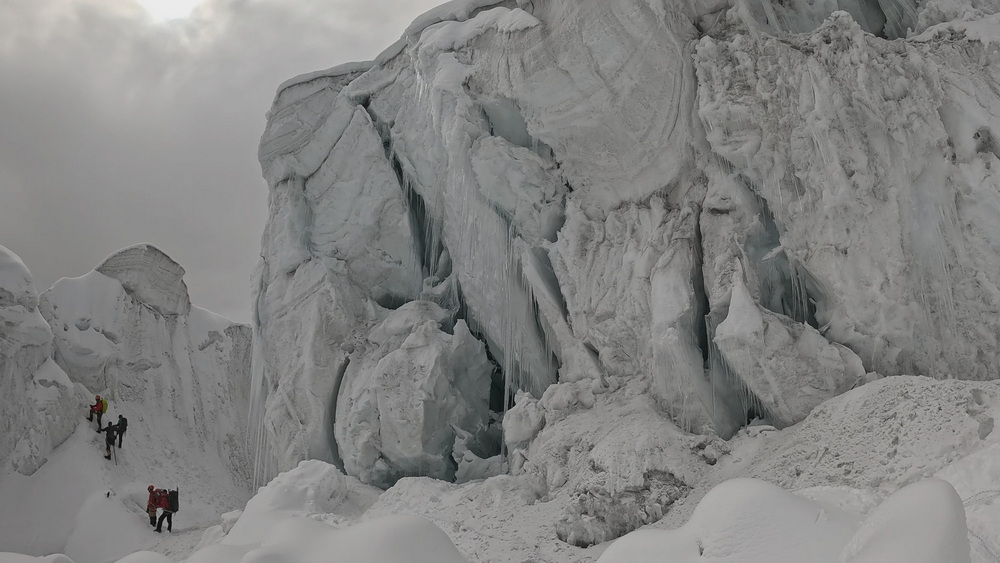
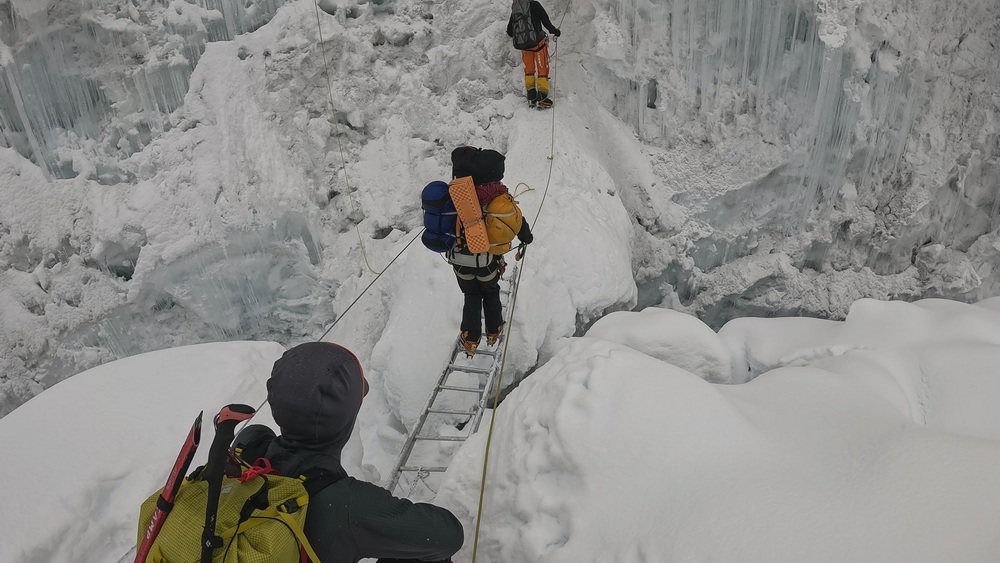
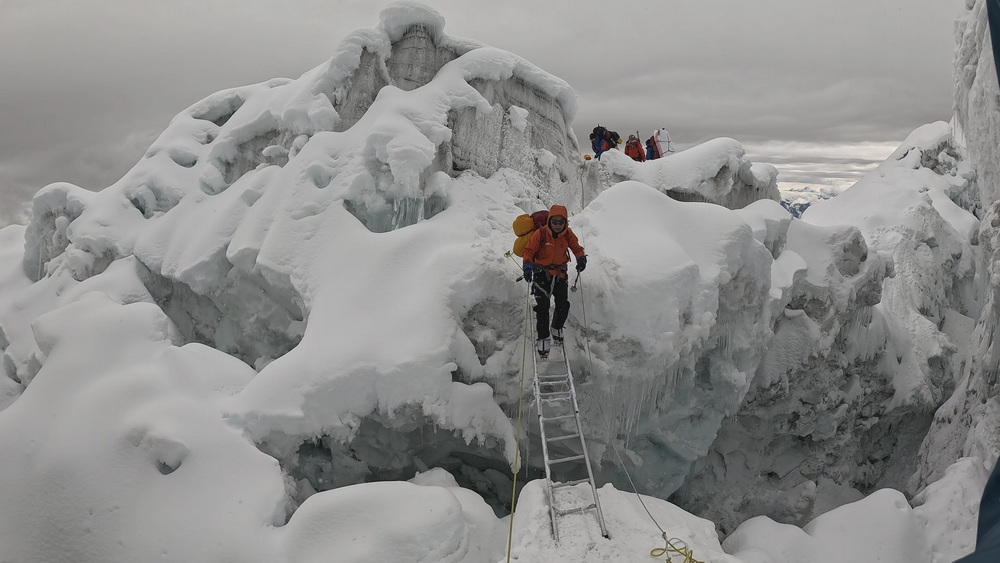
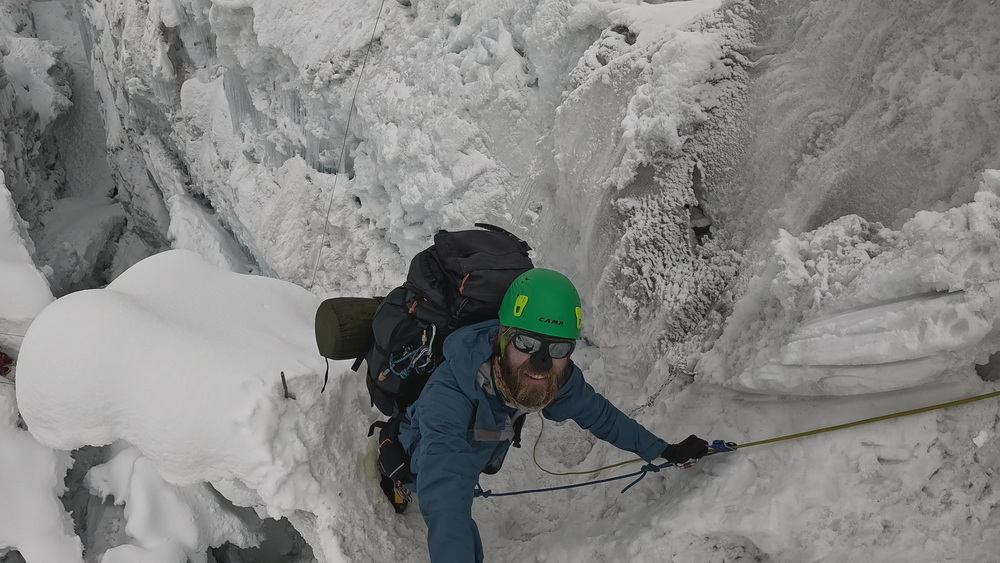
On the final ice-wall before the C2. Something bad happened to me.
While I was almost hanging in the middle of the wall, trying to push myself up with one leg, something hit me right in the knee (or at least it felt like a hit, like a shot. So painful.). It could be a chunk of ice or just some muscle pain, I still do not know exactly.
I’m trying to massage the knee (hanging on the rope) and climb further. After a couple of steps I lost a crampon on the other feet. It is just hanging useless on the strap.
How cool is that! One leg is sore, on the other I don't have a crampon. Well done!.
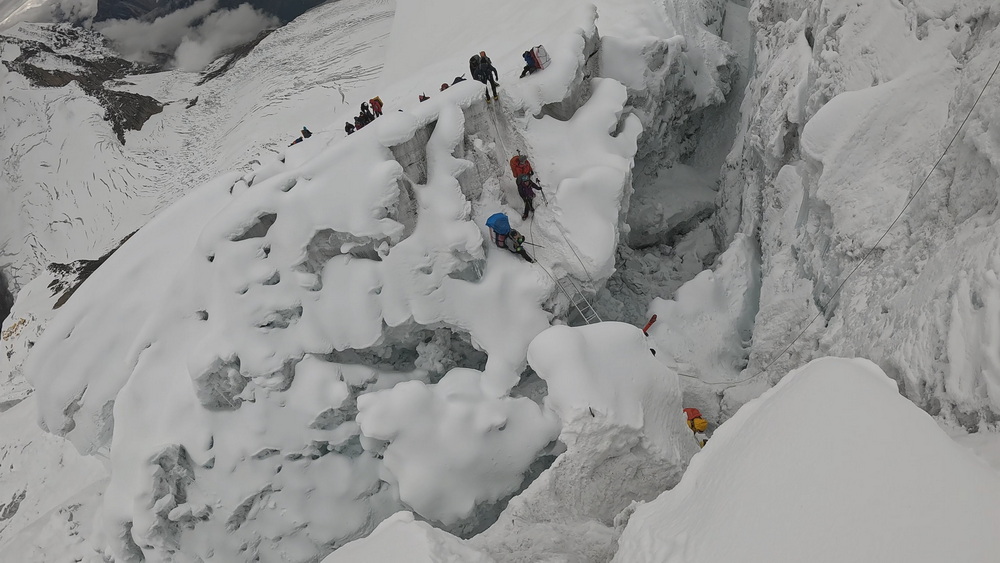
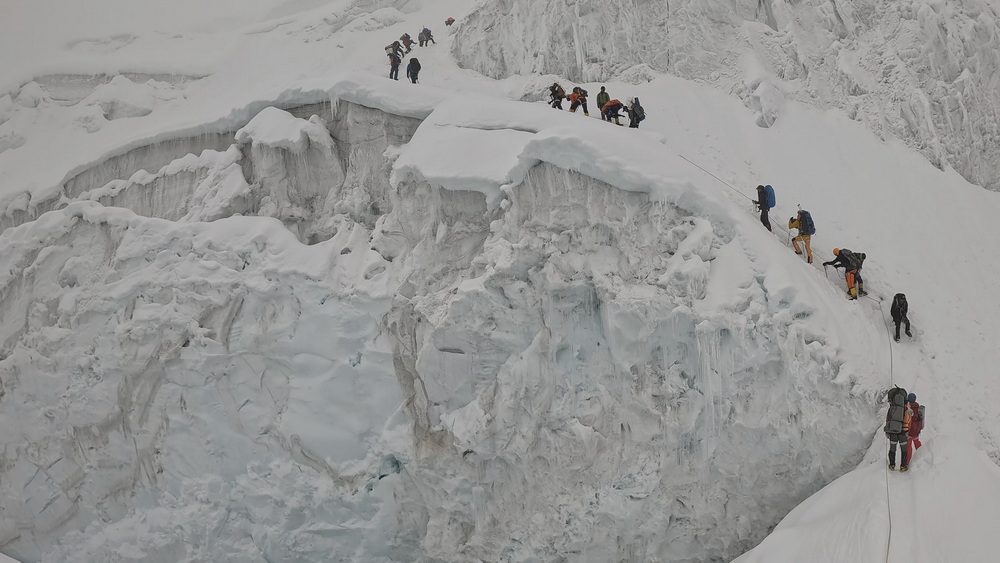
It was a miracle that I managed to climb up a few metres to the top of the wall.
There I can fix a crampon. And check what is wrong with my knee.
I didn’t find any visible damage on the knee ( no blood, no wound). I can stand on that leg if the foot is oriented straight. But if there is a tilt - it hurts, so much that I can't step on it.
With the help of walking sticks I managed to reach C2. Fortunately there were no more vertical sections.
I managed to prepare the place and pitch my tent there.
According to my plan the next day I wanted to go to C3 to spent a night there, or at least do a touch and go back to C2, depending on my feelings.
But the next day it was difficult to even go to the toilet place, which is located 30 metres from my tent. If I put the feet not directly straight it is so painful. And on mountain terrain you can not always put the feet as you want.
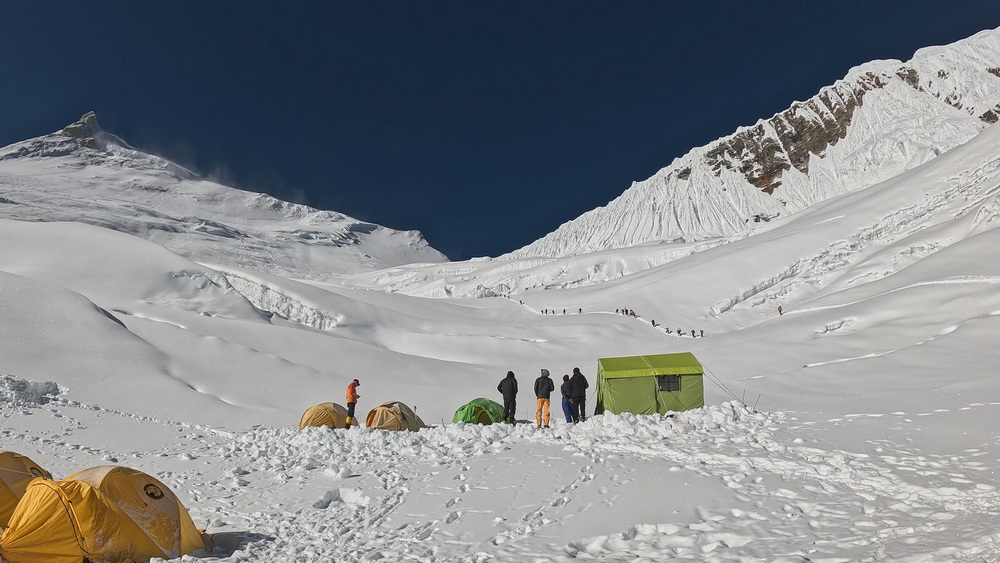
I’m facing a dilemma, I don't know what to do.
Going up is definitely not an option - there are technical sections like ice walls and steep icy slopes.
Same for the way down - route from C2 to C1 is the most technically challenging part.
Staging here in C2 - for how long, what if it is getting worse?
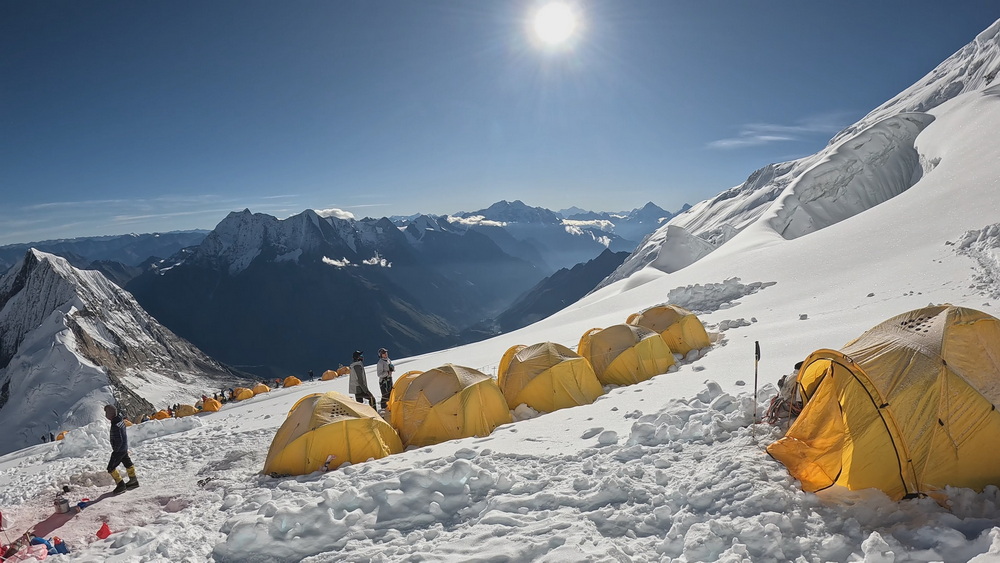
One more option - call for a helicopter to take me down. But it means the end of the expedition.
After a few hours of hesitation, and slowly limping in the camp, I made progress. Now I know how to put the feet to avoid pain, and which positions to avoid.
One more thing happened, that helped me to make a decision. But here is a small rewind.
In the base camp we have huge dining tents. There we eat, charge all devices and meet other climbers. There I met two nice guys from the Czech Republic - Jan and Libor. They also climb without oxygen and sherpas support. After that we met many times on the trail.
So, they arrived at C2 And by luck (or because they are better prepared) they have some medicine and elastic bandage. After applying all of it to my knee, I decided to try to go down.
I packed my tent and the stuff, left it in C2 as a deposit (because I simply can't carry a heavy backpack) and with an almost empty backpack started a descent at 2pm.
Fortunately there were almost empty trail, with no other climbers, so I do not need to pass anyone. Anyway It was damn hard and painful with a lot of swearing.
Finally about 7pm I was in the basecamp. From the crampon point I called there by radio and asked them to leave me something to eat for dinner.
Ok, now I’m safe, but what to do next? That's a good question!
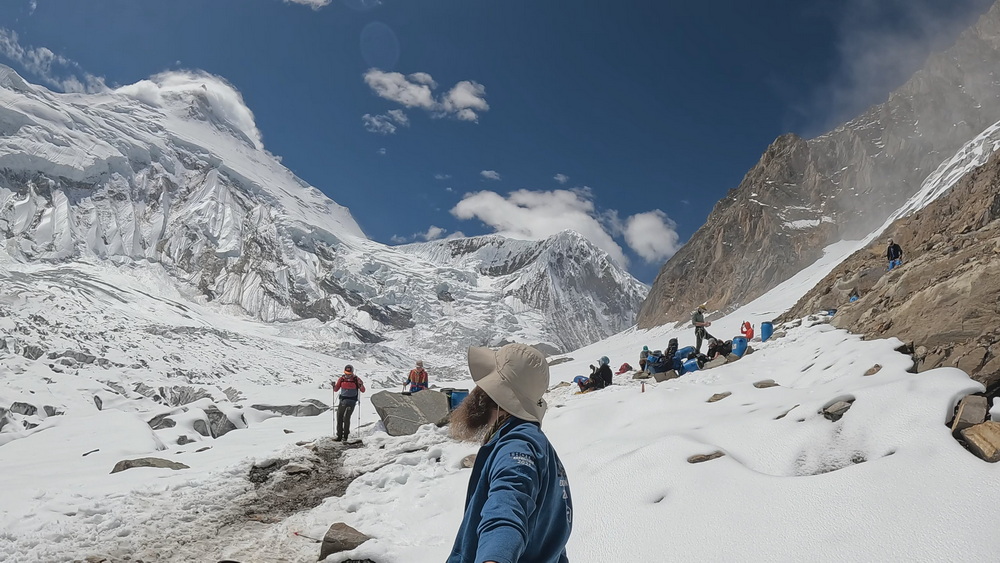
The next day I visited a doctor (yes there is a dedicated doctor in SST basecamp).
He said that most probably this is a muscle problem, not a ligament injury . And gave me special Iranian ointment.
After one full day of rest in the basecamp my knee feels much better. I can walk - slow but alamos no pain.
Bad news - weather forecast says that in 7 days there will be big snowfall (about 1.5 metres of fresh snow).
What does it mean for me? - Make a summit push before or wait for the next weather window.
Wait, I already had the same situation! On Lhotse. I waited for the ideal weather window. There was a snowfall (not really a snowfall, just some snowy days, like 40 centimeters of fresh snow) and it was enough to destroy the route and ropes with avalanches.
And here 1.5 metres predicted!
No way. I have to do it before. Because, I believe, after the snowfall chances to get a summit is almost zero. Ropes will be destroyed by avalanches, or at least buried under snow and after a few days that snow is hard as concrete. So now or newer!
But wait, I have a problem with my knee. Surprisingly just after two days of rest in the basecamp (an applying of that magic Iranian ligament) I managed to go to the crampon point and back to basecamp.
I decided to give it a try and the next day I want to start an ascent.
As you remember, at the very beginning I said that I want to make it without oxygen.
Now it is obvious that I can not do it in these circumstances. I’m not enough acclimatised, just one night in C1 and one night in C2 - it is definitely not enough. And I have no time to do one more rotation before the snowfall.
I decided - It’s better to have a summit with oxygen, then not have it at all. And I bought two bottles of oxygen.
One of them I’m going to carry from BC (it costs me 500$) and the second one I’m going to pick up in C2 (which costs 700$). I just want to minimise the weight and keep my knee safe (as far as possible).
Also, from the basecamp I have to go directly to Camp 2 - because my tent and all other stuff is there. I have nothing to have a night in Camp 1.
Summit Push
As planned the next day, I’m heading to Camp 2.
I wanted to have my backpack as light as possible, but it is anyway heavy. I have one bottle of oxygen, a regulator and an oxygen mask. My down suite, summit mittens, some additional snacks, and some electronics. I guess the total weight is about 15 kilos. Not much, but not as small as I wanted.
I started right after breakfast, to have enough time to get to the Camp 2.
The same way that I already did. This time it is much easier - acclimatisation works. I’m walking slowly and carefully to protect the knee. So far so gut.
Short rest in Camp 1 and continue of the ascent. Now there are much less climbers on the way. I think most of them had a night in Camp 1 and started ascending to Camp 2 early this day. Good for me.
Finally I’m in C2 super exhausted, but in general all good. Pitch my tent on the same spot ( no need to dig snow once again).
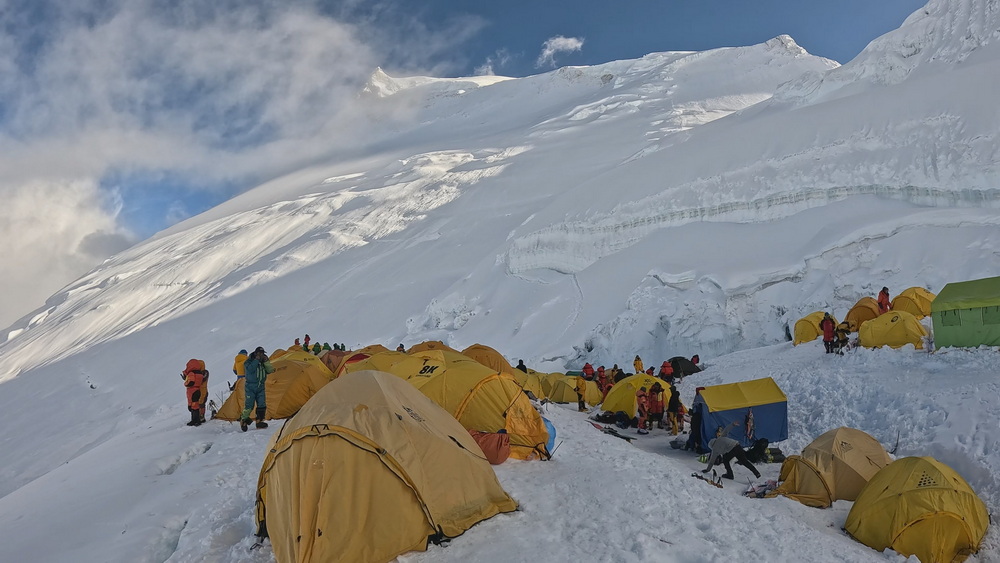
The next day I’m going to carry my oxygen to the Camp 3. Before the night I’m going to be back here in Camp 2.
The way to Camp 3 is not so long - it is about 3-4 hours up, and less then one hour down. There are a couple of difficult sections, but in general it is less demanding than the way from Camp 1 to Camp 2.
All went according to the plan and I’m back in Camp 2. One more night here and tomorrow I’m going back to Camp 3 with equipment for the summit push - down suite, mittens and snacks.
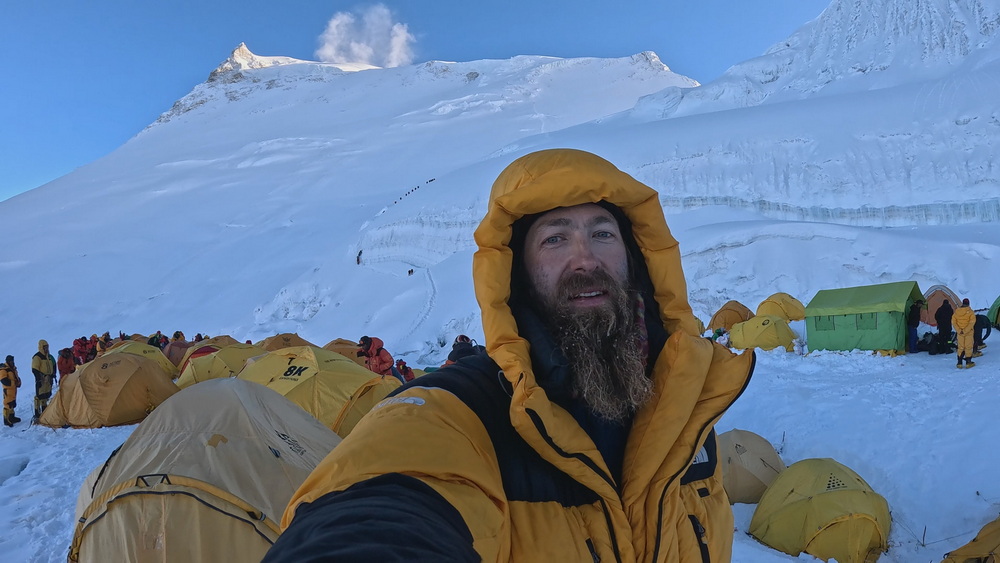
The next morning I packed all the stuff that I needed for the summit in the backpack. And all the stuff that I do not need - to leave here. So I left the tent and the sleeping bag.
I’m not going to sleep in Camp 3. According to my plan I’ll arrive there at lunch time and then I'm gonna start further ascent at sunset.
One thing that I decided to take with me at the last moment - my slipping mat. So I can sit or lay - as I don’t have any tent or other place to rest there.
And it was good idea. When I arrived in Camp 3 there were plenty of people - climbers going down from the summit, climbers that will go tonight to the summit. I barely found a relatively flat spot to put my mat right on the snow. There is nothing to do, so I just relaxed until the moment when the sun set behind the ridge. Before it was warm - no wind, hot sun, and 1 minute after it became cold, so I rushed to take on my down suite.
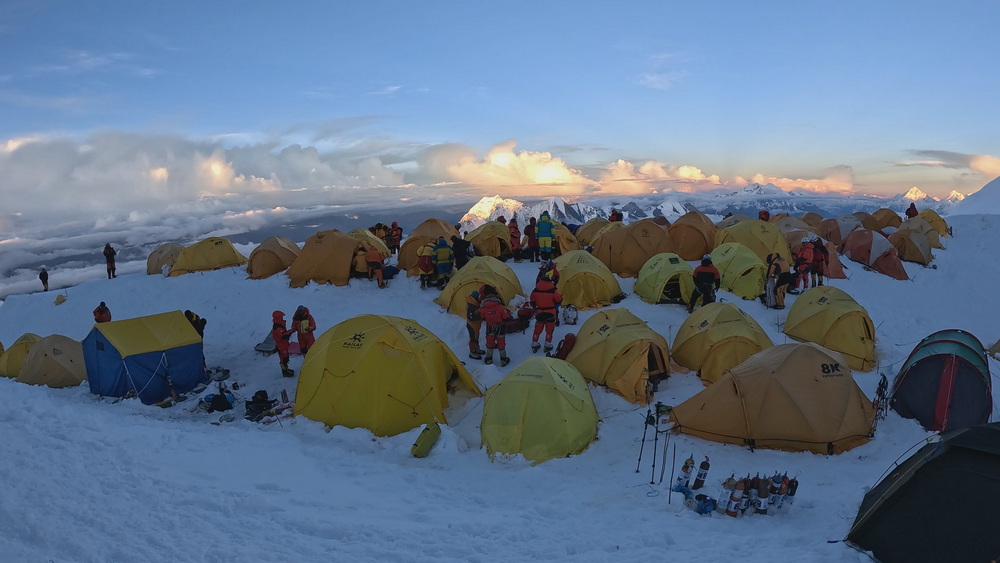
All climbers started slowly preparing all needed for the summit push.
The first group started about 5 pm. The main amount of people - I guess more than 100 climbers + the same amount of sherpa guides started from Camp 3 from 6 to 6.30 pm.
I decided that I’m the smartest guy here and do not want to go with the crowd and wait in queues on the wall in the middle of the night. So when all those people left the camp, I crawled in the storage tent to sleep.
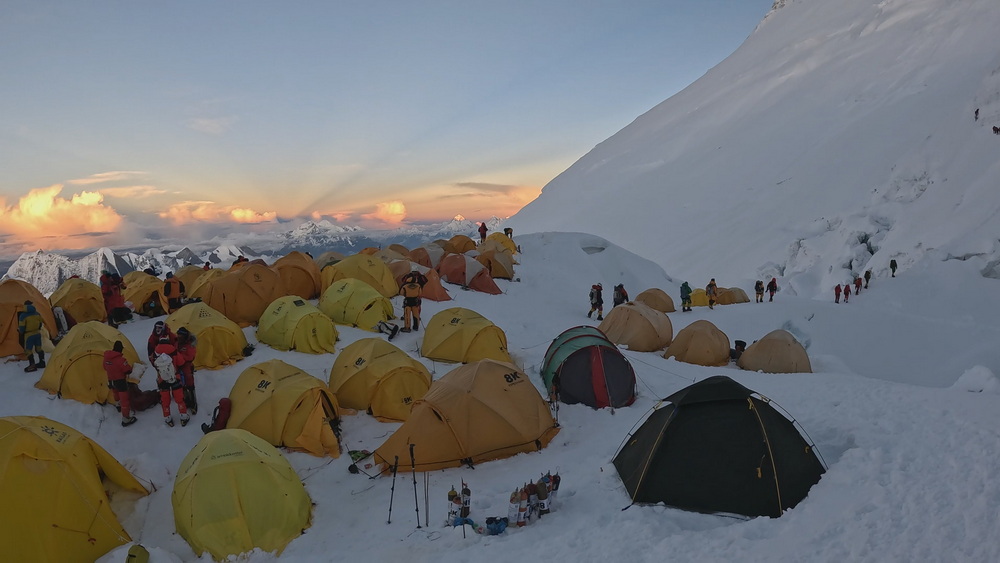
3 hours later at about 9pm. I started my ascent.
There was nobody around, just some lights far ahead. The weather is good - almost no wind, good visibility and relatively warm, I think about -15 C.
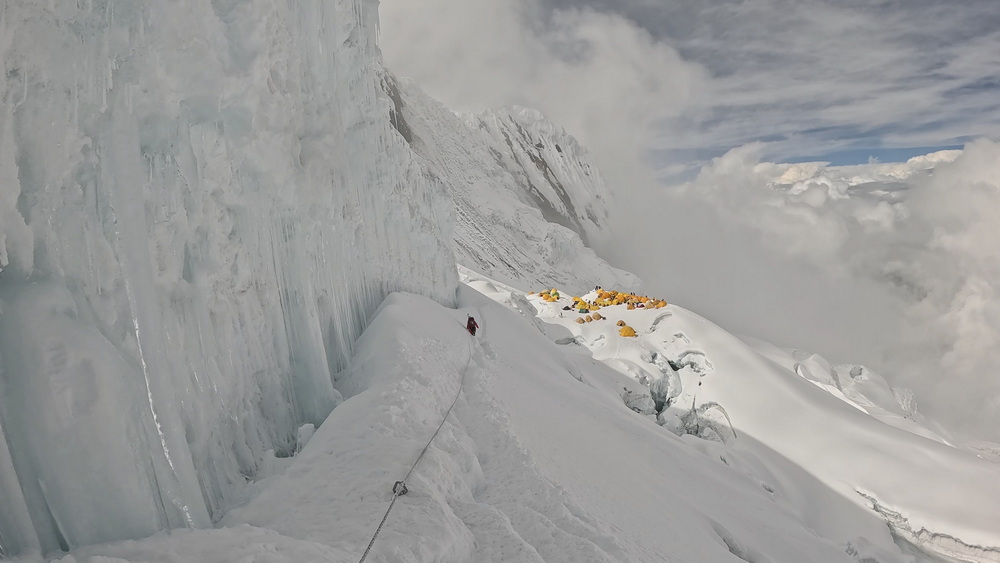
Almost right after I left the camp, there is a steep slope without any flat spots for rest.
I hate this part of the climbing experience when you have to climb in the darkness. Nothing is going on - you just move your legs, but nothing changes around - same small spot of light, the same snow and ice and endless rope.
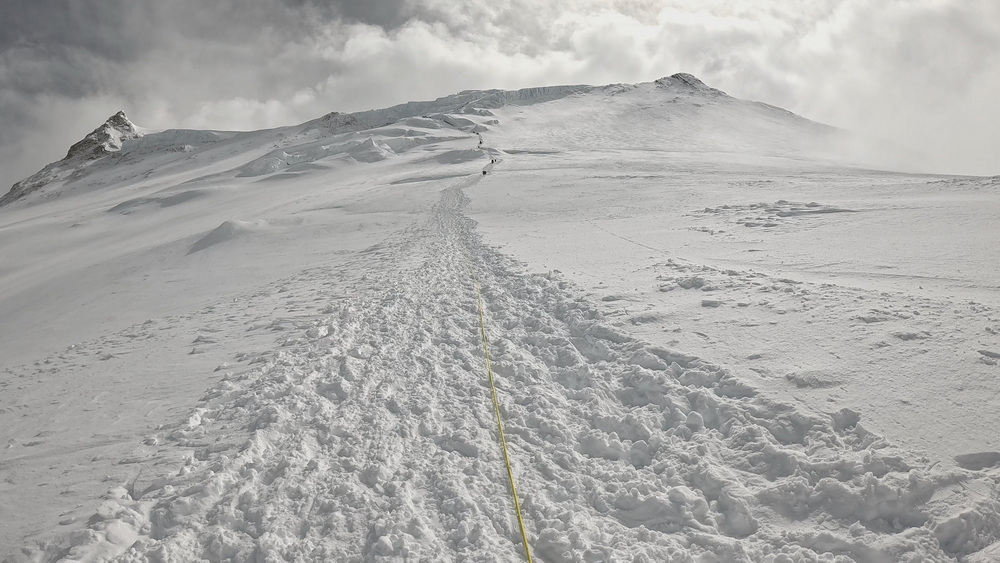
After a few hours I managed to catch up with a sherpa guy. He was climbing without oxygen, so that is why he was slower than me. The group of lights far ahead of me remain at the same distance (at least it does not seem getting any closer, but it is hard to judge).
Climbing alone at night on this huge mountain feels absolutely mental. And scarry. I wish to have somebody around. Maybe staying in queues is not so bad? - that was my thoughts at that moment.
After a few more hours I reached the upper part of this slope. There was a significant wind that blew the snow from the slope above. And I found out a new problem of climbing alone - no footprints and deep fresh snow. There was a section that almost destroyed me - a very steep section of the slope that you need to traverse uphill. Take a step and you slide with the snow back to the same place. It was a fight. But finally I managed to do it.
Suddenly I’m on an almost flat surface and there is a wide good trail on the snow. I was surprised. Should I expect to see a mountain hut with apple pie and mulled wine next?
But there was just Camp 4 at an altitude of 7400 metres. Some tents, some lights, and … some people!
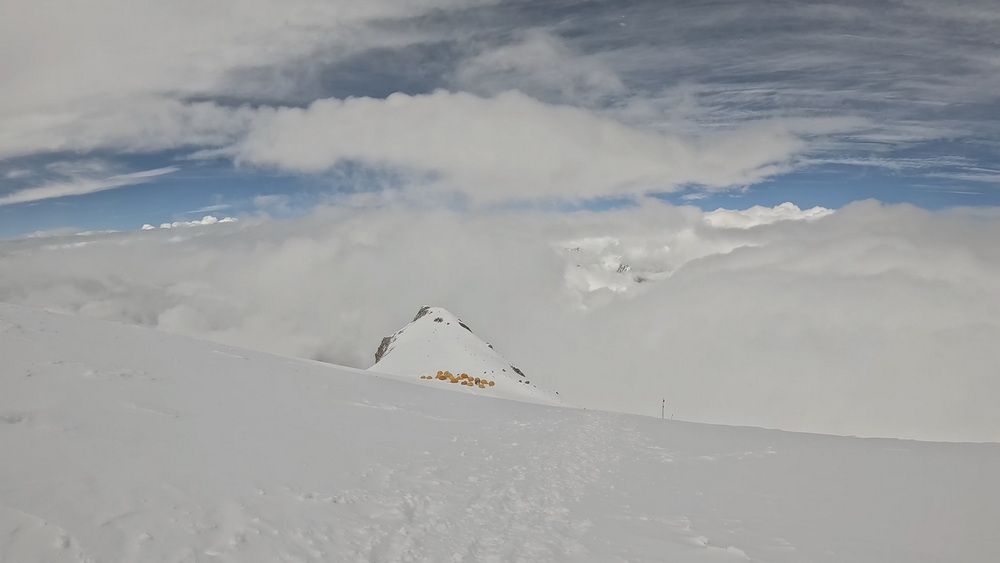
And actually here was the coldest place - I was inside a cloud - mist around, quite windy and the time - just before the sunrise (about 4am.). It felt very humid and cold. I just took a rest for 5 minutes to eat a snack and drink some hot water, but was forced to move by this cold.
Here the terrain is much easier - no need to use a jumar. There are places where there is no rope at all. Just some sticks to mark the way. So it should be easier to walk here, but… the altitude. I take a few steps (well, maybe not few, more like 10 to 20) and need some time to catch a breath.
At this time it began to get light. And it already started to feel much better. At least you see where you are now and the path. And it is fucking long way ahead - endless slope and no summit I can see.
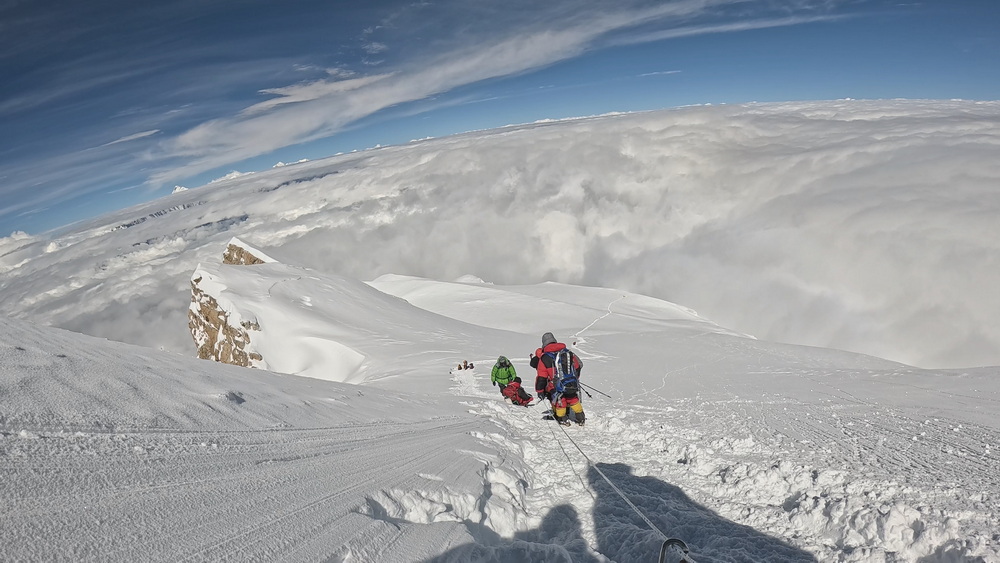
Right after Camp 4 I finally managed to meet some other climbers on the way up. They were walking so slow, so I passed them. And starting from this point there were many other groups and climbers - some on the way up, some on the way down (most probably without summit, it is too early to reach the summit and went down).
Few hours later … I started to worry if I have enough oxygen. I’m on the second bottle now(the first one I already left on the way to C4). This is a funny (or maybe not so funny story, rather sad). I’ll tell you about it at the end of this article.
So now I’m using my second and the last bottle of oxygen and there is 110 bars left, out of 270).
According to my current consumption - 2 litres of oxygen per minute and the size of the bottle of 4 litres. I have 440 litres. Which means 220 minutes, so slightly less then 4 hours.
When I’m calculating it at home, it is so easy and obvious… But there at the altitude about 7600 meters in the thin air it was a rocket since to calculate. I did it like 10 times and still was not sure if I had the right answer.
And how much time do I need to reach the summit? Do I have some for the way down? What if I run out of oxygen right on the top?
I was asking other climbers - how far is the summit? And the answer was not satisfying - maybe 3 hours, maybe more.
Some time later I met a guy who was fixing something on the side of the trail. Next to him there was a mitten laying on the snow. Accidentally I spotted that this is a not typical brand that everybody uses - it is a Ukrainian brand - Fram equipment. I was surprised and said "Привіт". Which means - hello. And apparently I know this guy. We already met on Lhotse! What a surprise.

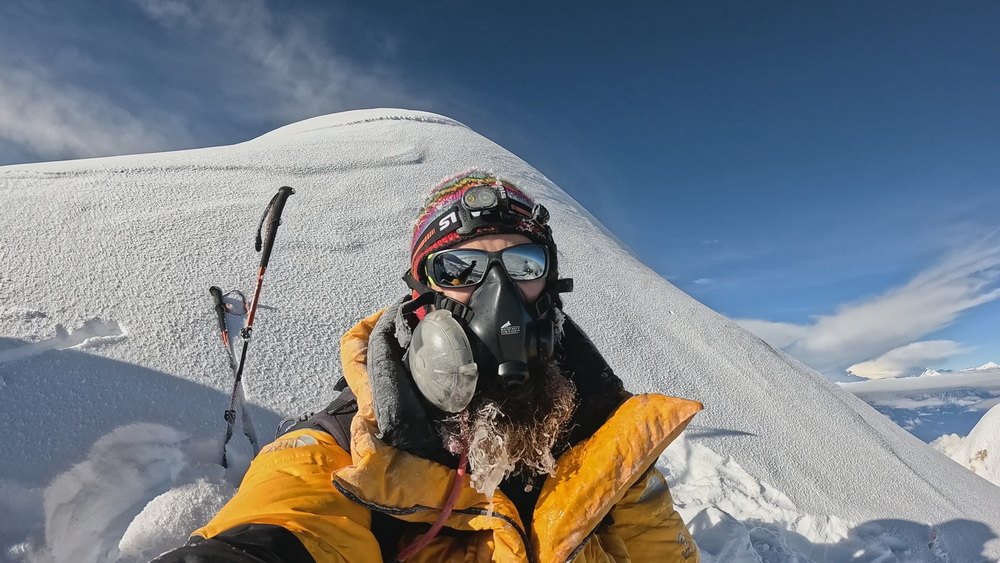
I shared my concern about oxygen, and he confirmed my calculations. And said that there is more or less 2.5 hours to the summit. So I have something to breathe till the summit and something to go down lower than 8000 meters. In theory. With this conclusion I continued to ascend.
And after more or less two hours, suddenly I reached the place, from which I see the summit (more or less) and it is very close, literally close, I’m almost there.
What a surprise! During the whole way there were some doubts - what if? You know, the weather is getting worse, I’m out of oxygen, I cant go any further… Lot of things can go wrong.
At that moment, I understood, I’ll do it. Weather is perfect - sunny, no wind, still have some oxygen.
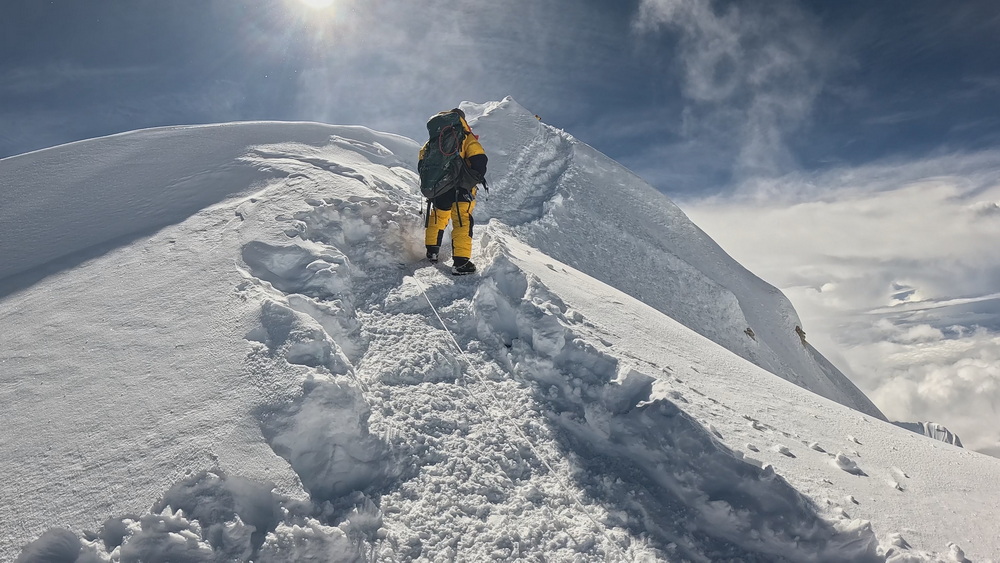
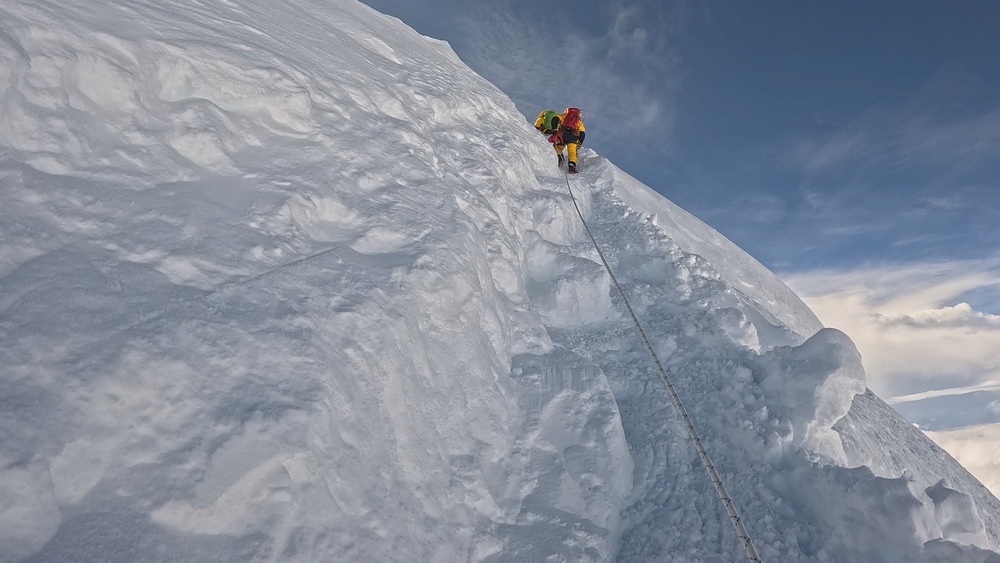
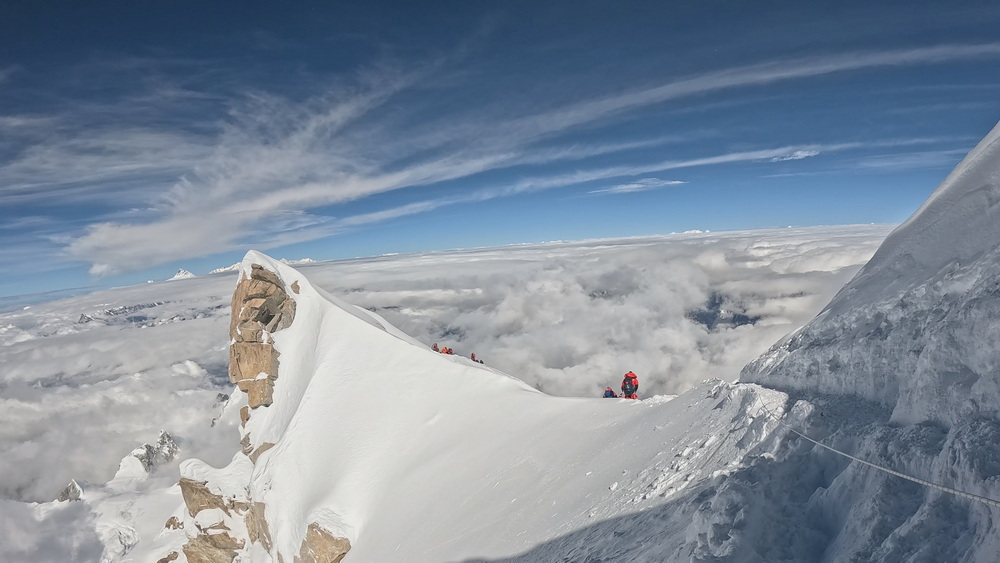
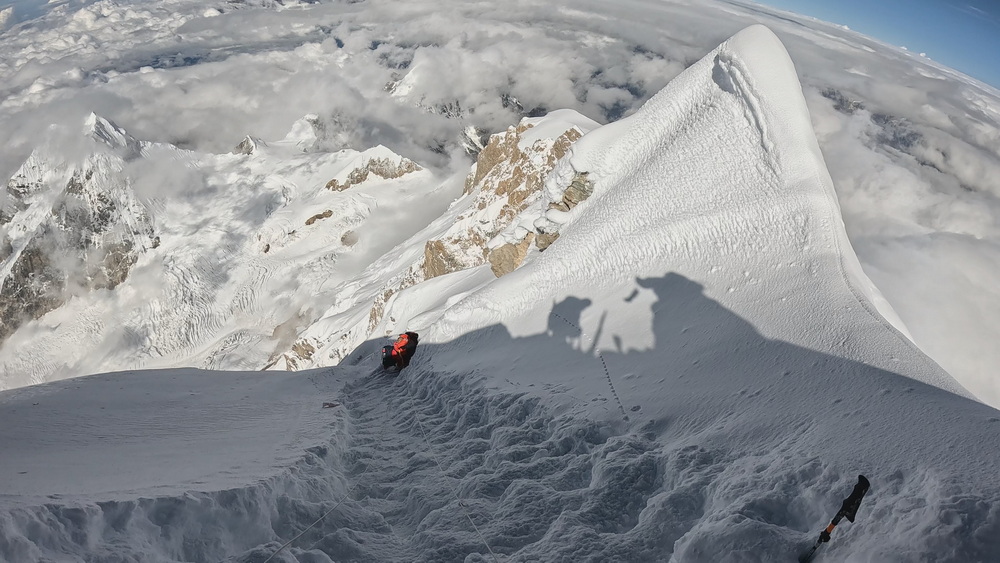
This place is at the base of the false summit, before 2022 almost all expeditions use it as the end point. But the true summit is a few metres higher and there is a few hundred meters further. There is a super steep slope that you have to traverse to the real summit. Nothing technically difficult, just a very exposed section. Nothing below you, almost a vertical wall…
One more turn behind the rock and I see the summit, just 15 meters from me. And the queue of climbers. The summit is super narrow, there is a place just for 2, maximum 3 people. And everyone is willing to have a photo from the summit. Also it is required to confirm that you actually reached it. After 10 minute of waiting, I’m finally on the top of mount Manaslu - the eighth-highest peak in the world, with an altitude of 8,163 meters. The time is 8.40 am. So it took almost 12 hours of climbing from the Camp 3 to the summit.
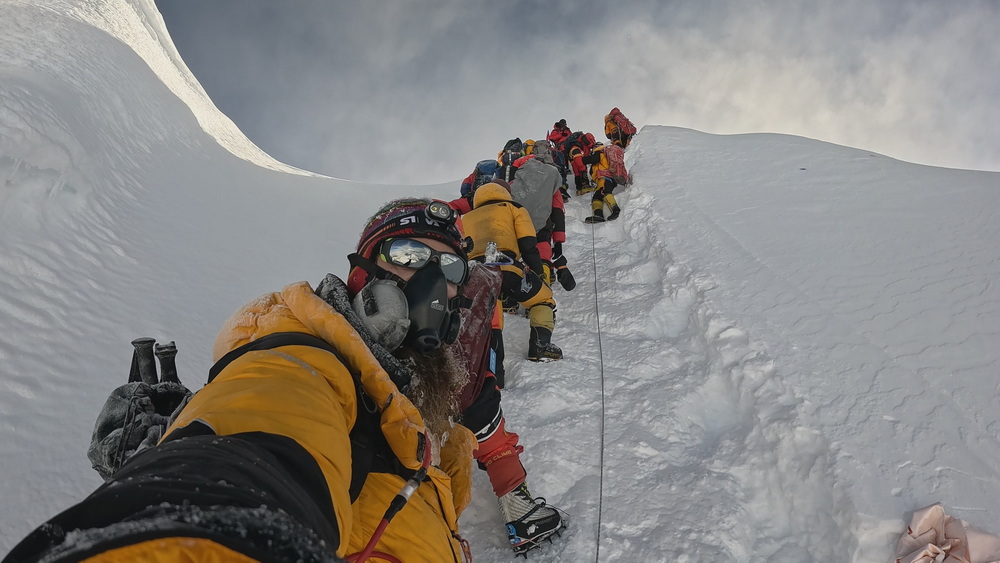
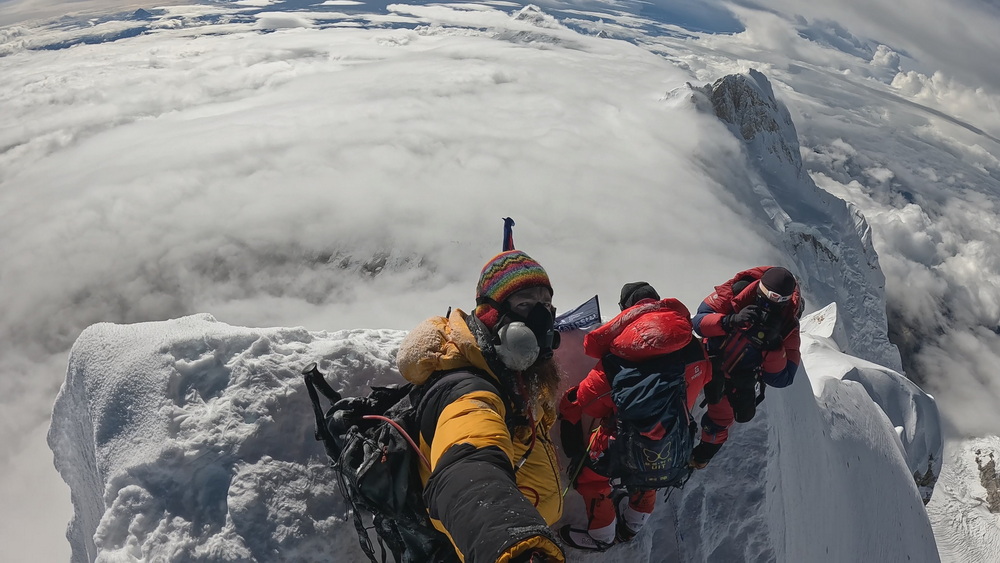
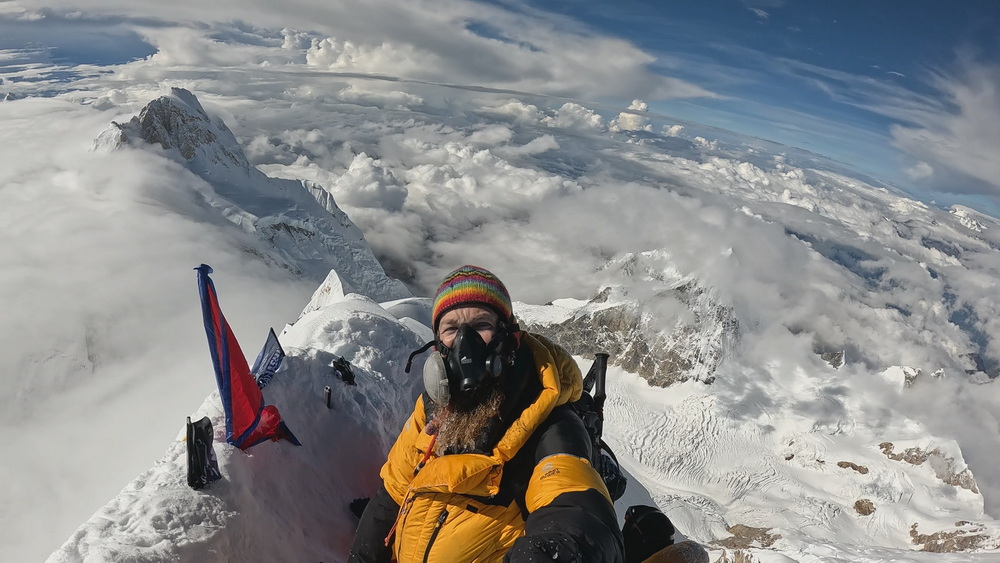
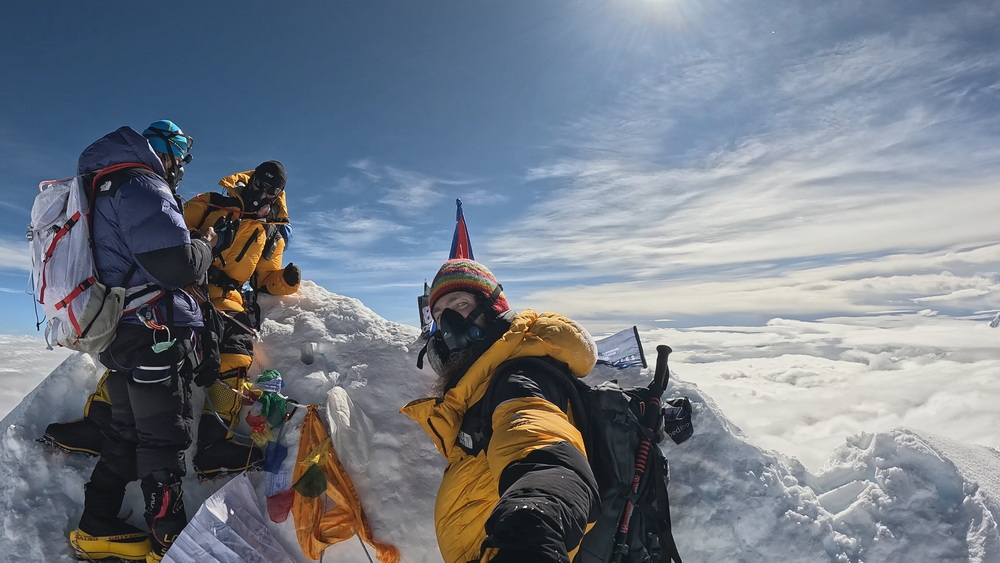
The weather is perfect - no wind, sunny, good visibility (above the clouds). Actually there are a couple of other eight-thousanders that you can spot from the top.
Now it is time to go back down. Despite the way down is much easier and faster, it is extremely hard. My body is already exhausted from the long climb. And it is not only my problem, I saw some people that barely can walk without help of sherpas. I can not rely on help.
The way to Camp 4 is relatively simple - just walking. So I did it with some breaks for rest and filming. And after Camp 4 there is that super steep section. What can I say, during the day it is not so scary, especially on the way down. And now there is no wind that wipes out all footprints. I picked up my first bottle of oxygen (that I’ve left during ascent).
Around 2pm, I’m in Camp 3. Here I take a longer break to rest. I’m so happy that I have my slipping mat here. I took a nap before continuing descent to C2. If you remember, all my equipment is there - tent, sleeping bag, food. So I have to go there, I can't stay in C3. Fortunately it is quite close and after one hour I was there around 5.30pm.
The chief in the kitchen tent was so kind that gave me something to drink. Since the start of summit push I maybe have 2 litres of water in total. Starting from the summit I felt thirsty. As soon as I was in the tent I fell asleep, despite wanting to have some dinner. Woke up at 9pm and decided that it was too late to eat and fell asleep again.
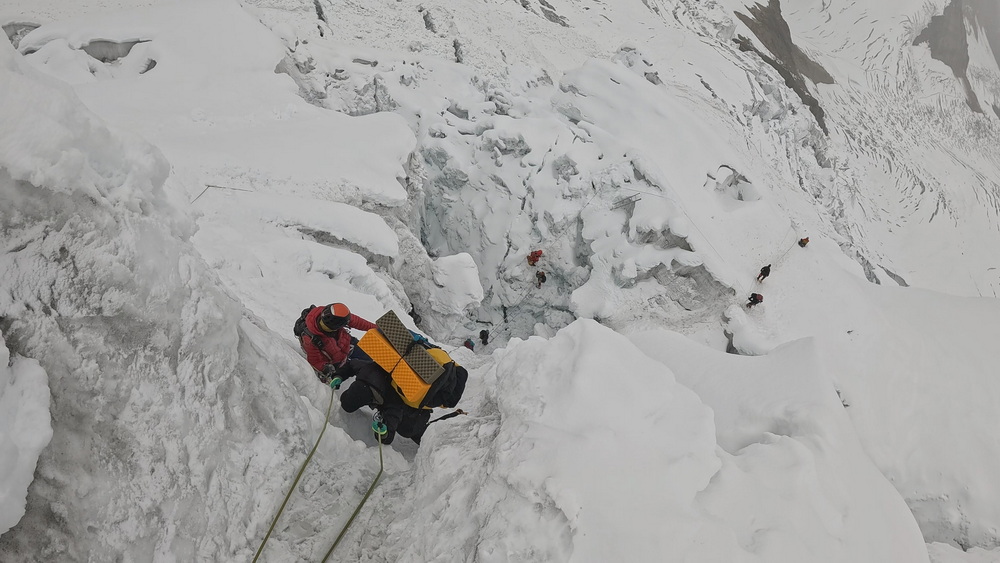
The next morning it is time to pack all my stuff and go back. The backpack was so heavy that I decided to leave something there. So I left all the rest of the food, gas and even some clothes. All because of those oxygen bottles, they are damn heavy. Couple of times I stayed in queues in difficult places between C2 and C1, though it was good to have some rest. That backpack is killing my, so heavy. At the end of the way I felt like I needed a rest every 10 metres. In the C1 I have a longer rest before the final push to the basecamp. It was very long and exhausting, but nothing interesting.
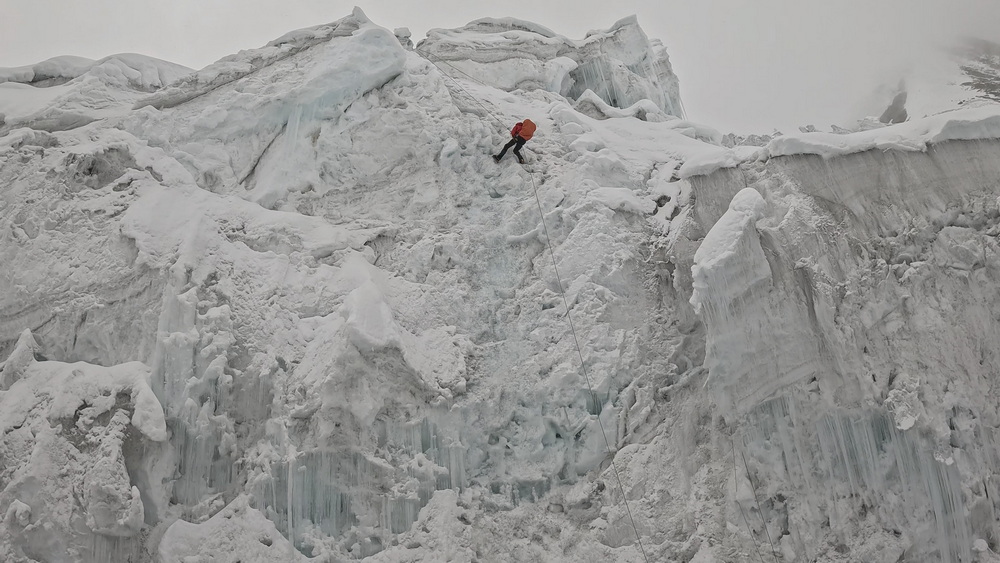
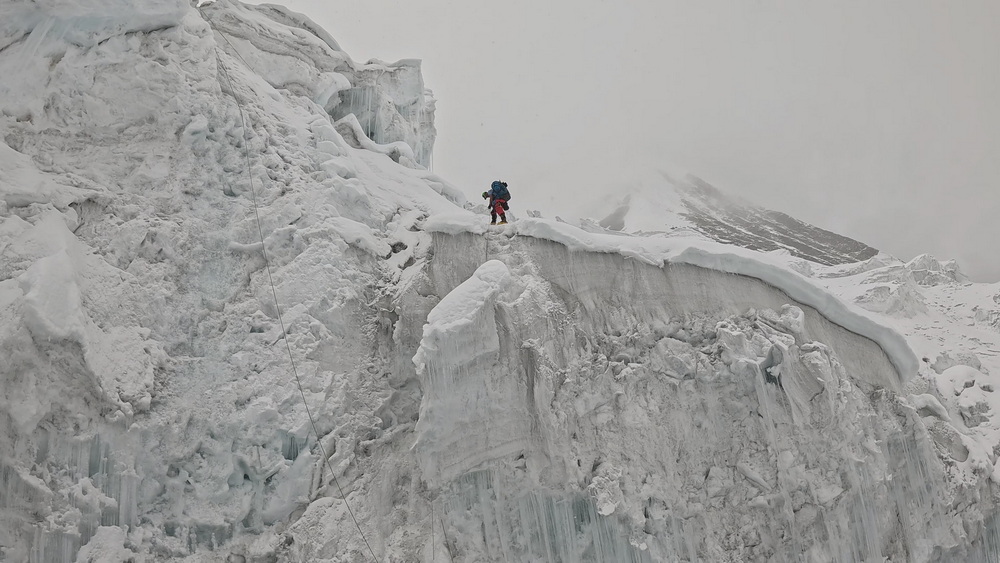
And finally I’m in the basecamp.
Congratulations from the team and other climbers (many of them also did it the same day or day before me).
There was a celebration cake from our kitchen team and finally I can have a beer.
Oxygen
Meanwhile you can see how that snowfall changed the basecamp. And apparently that was one of the strongest snowfalls in years. Down the mountains there were record breaking rains. More than 200 people have been killed and thousands of houses damaged by the flood. After the snowfall no climbers managed to reach the summit, despite trying. The way to C4 was destroyed. So I’m glad that I made the right decision.
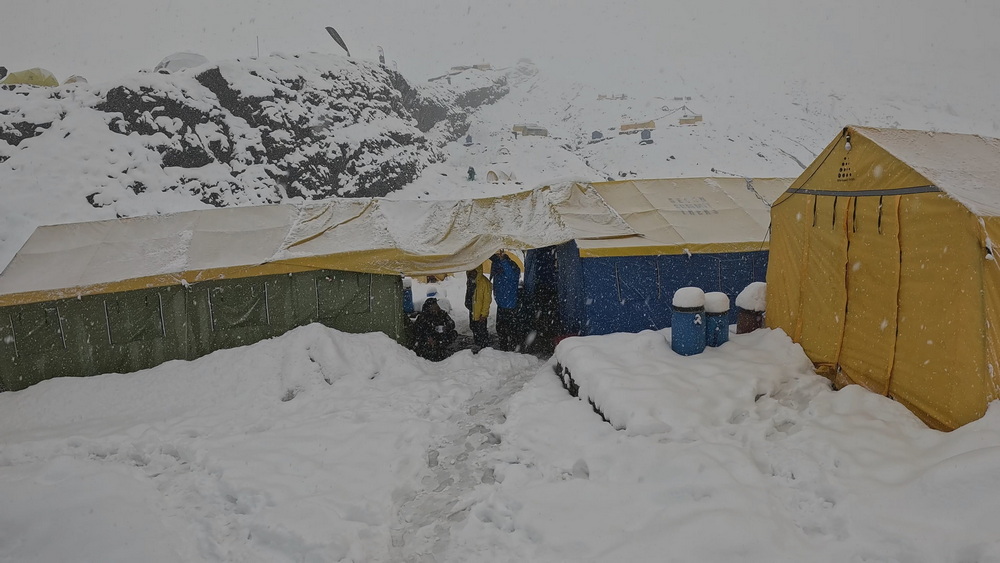
Back to an oxygen story. Before leaving Camp 4 I plug the regulator and the mask to the bottle and put it to the backpack.
After some time (maybe 1 hour of climbing) I noticed a very quiet sizzling sound from the backpack. But I decided that it is ok. Probably that is the way the regulator works and continued ascent. And a short time after I felt that it was actually very hard to breathe. That is definitely not how it is supposed to be. I checked the marker in the oxygen pipe and it was on zero, so no oxygen was coming. What the hack?
I took off the backpack to check what was going on and sow that the pressure gauge on my oxygen bottle was zero. So it is empty. What the fuck, there should be enough oxygen for about 8 hours (for 2 litres per minute consumption, and I was on 1.5 litres). Probably I did not tighten enough the regulator and there was a leak between the bottle and the regulator. Or maybe something is wrong with the regulator (dead seal somewhere). I don't know and anyway there is no way to fix it here. This was kinda a disaster, I’ve lost half of my oxygen at the very beginning of the way.
Anyway I decided to continue until I can. I plugged in the second (and the last) bottle and tried to screw it on as tight as I could. No leaks, at least I could hear no sizzling. So I left an empty bottle there, just stuck it in the snow to pick it up on the way back. Since that point I constantly was listening to suspicious sounds and checked the consumption many times. All was good.
The rest of the story you already know.
Ah, one more thing! When I was returning bottles at the base camp I noticed that one is significantly heavier than another one. And I thought, maybe it wasn’t totally empty? Maybe the pressure gauge was on zero because the regulator simply unscrewed from the bottle? And maybe there was plenty of oxygen?
We will never know!
Thank you for staying with me till this moment.
Will I try climbing 8000 meter peak again? Why not!
You may also check the video version of this story (with a lot of awesome shots) on my Youtube channel - https://www.youtube.com/@JustFromThere
In this expedition, I use some equipment of the brand Turbat. I have a base layer, fleece jacket and waterproof jacket. I used it all the time - during tracking, rotations and even summit push.
It is designed and produced in Ukraine. But you can find and buy it in many European countries, Canada, New Zealand and Korea.
This is not an ad, they didn’t pay me, I just wanna share my experience and support them. So if you need great equipment and you also want to support the Ukrainian brand - you are more than welcome.
